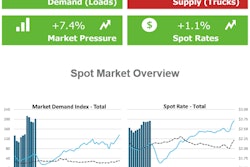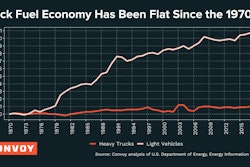Following February's weather disruptions, truckload freight shipments settled into more normal patterns during the week ending March 14, said DAT Freight & Analytics, which operates the DAT load board network. The number of loads posted to the network fell 11.4% and the number of trucks increased 9.2%, compared to the previous week, portending likely rate declines this week. Yet prior weeks' extremes in the other direction last week brought rates to a high plateau, well above averages for February.
National Average Spot Rates, March
**Van: $2.70 per mile, 30 cents higher than the February average
**Flatbed: $2.70 per mile, 14 cents higher
**Refrigerated: $2.95 per mile, 26 cents higher
The gains have been offset for owner-operators on higher costs, too, as diesel averaged $3.19 per gallon last week, up nearly 5 cents compared to the previous week.
That said, the seven-day average van and reefer line-haul rate, which excludes a calculated fuel surcharge to separate out owner-operators No. 1 cost's volatile effect, were at all-time highs for the DAT network.
 The van linehaul averaged $2.40 per mile, and the reefer rate was $2.61.
The van linehaul averaged $2.40 per mile, and the reefer rate was $2.61.
Flatbed demand stays elevated
Flatbed load post volumes have been on the rise for four weeks in a row and the national average flatbed load-to-truck ratio rose from 74.6 to 77.6 last week, more than 15 points above the February average.

The average spot rate increased on 50 of DAT’s top 78 flatbed lanes by volume compared to the previous week. Twenty-two lanes were neutral and the rate declined on six lanes. The country’s busiest lane for spot flatbed freight last week -- the intrastate Lakeland, Florida, to Miami -- averaged $3.15 a mile and is up 11 cents over the past four weeks.
Flatbed market to watch
Baltimore, Maryland, is the number one roll-on/roll-off (RoRo) port in the United States, and handles most of the East Coast’s market share of such cargo annually. Baltimore’s proximity to major farm and construction equipment manufacturers in the Midwest makes it a key origin point for agriculture, farming and mining machinery. According to import data from PIERS, tonnage of RoRo equipment in February is up 301% year over year. Construction equipment represents 66% of total RoRo volume imports through the Port of Baltimore or the equivalent of 600 truckloads in February, which is about 340 more truckloads compared to February 2020.
Van volumes level off, markets to watch
While the number of loads moved was up 2% across DAT’s top 100 lanes for van freight, overall van load post volumes fell 23% week over week. With 11% more truck posts, the van load-to-truck ratio dropped from 7.81 to 5.43. The average rate improved on 44 of DAT’s top 100 lanes, was neutral on 27 lanes and was lower on 29 lanes.
Pricing held firm in key van markets despite declining outbound load volume, indicating that capacity is tight. In Memphis, Tennessee, volume was down 10% but tight capacity helped push the average van rate up 9 cents to $3.29 a mile compared to the previous week. In Atlanta, load volume declined 13%, yet the average rate increased 5 cents to $2.74 a mile. And in Los Angeles, the average outbound rate increased 2 cents to $3.32 a mile despite 27% less volume.
Reefer rates cool a degree or two
Spot rates in the reefer sector remain exceptionally high for this time of year. At $2.95 per mile, the national average spot reefer rate is 75 cents higher compared to the March average in 2020. Colder weather in the upper half of the U.S. this week should have kept reefers in demand as shippers add “protect from freeze” to bills of lading to prevent temperature-sensitive dry freight from freezing.
Load post volume in the temperature-controlled sector dropped by 23% week over week. With 8% more truck posts last week along with fewer load posts, the reefer load-to-truck ratio slipped from 15.62 to 11.02. The number of loads moved on DAT’s top 72 reefer lanes by volume was virtually unchanged compared to the previous week. The average rate, however, was higher on 43 of those lanes, neutral on 12, and lower on 17 lanes. Again, tight capacity is providing a toehold for spot truckload rates.










